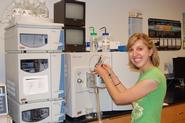
Clad in pseudo-space-age garb, Sarah Andrus ’12 looks somewhat out of place striding through a grassy field and not bounding over lunar craters. Despite her more mundane surroundings, Andrus’ quest still leads to an exploration of sorts: she is collecting samples of honeybees and fruit flies for her research with Associate Professor of Biology Herman Lehman. These samples may help to dispel some of the mystery surrounding the effects of a little-understood compound called octopamine.
Andrus will be spending a lot of time not only with her winged friends, fruit flies (Drosophila melanogaster) and honeybees (Apis mellifera), but also with her more land-bound pal, the tobacco hornworm (Manduca sexta). Besides being populous and commonly used for research, these insects are good subjects because they produce octopamine, a type of organic compound that is created only by biological processes. Octopamine is known to affect physiological and behavioral responses in invertebrates.
But the effect of different levels of octopamine in organisms is still unclear; it may influence foraging behaviors, but the effects of more or less octopamine remain little understood.
For his thesis in neuroscience, Stephen Chaponis ’10 figured out how to both detect and quantify octopamine. After dissecting the organisms’ brains and putting them in a solution, he used HILIC (Hydrophilic interaction liquid chromatography), a procedure which uses electron flow in the brain to detect octopamine. After detecting the compound, Chaponis also ran the solution through a mass spectrometer, which can be used to select compounds based on their retention time and molecular weight. Mass spectrometry is more highly selective than HILIC and can quantify just how much of a compound is in a solution. In the long run, this detection and quantification could allow scientists to vary the levels of octopamine, finally showing what its effects are on an organism.
For her part, Andrus is taking Chaponis’ research to the next level. She will first run Chaponis’ experiment, “just to make sure I can do it,” she laughs. She will then manipulate the variables, such as the buffer solution and gradient elution, to quantify octopamine even more accurately, as some “background noise” still exists that interferes with the preciseness of the results. Then, using this extremely accurate method, Andrus will run a similar solution to detect other types of compounds found in the brain, such as dopamine, tyramine, serotonin, and acetylcholine. Although some of these compounds have been studied extensively and their effects are well known, the ability to easily detect and quantify them has endless scientific potential. And, if this process can so accurately detect all of these different compounds, it could be applied to other, more enigmatic compounds whose effects are not yet well understood.
Besides spending time with her insect friends in the lab, Andrus is a member of the Hamilton College choir and the a capella group Duelly Noted. She enjoys hiking and skiing and will be studying abroad in Paris during the 2010-11 academic year.
Sarah Andrus '12 is a greaduate of Hanover (N.H.) High School.
Andrus will be spending a lot of time not only with her winged friends, fruit flies (Drosophila melanogaster) and honeybees (Apis mellifera), but also with her more land-bound pal, the tobacco hornworm (Manduca sexta). Besides being populous and commonly used for research, these insects are good subjects because they produce octopamine, a type of organic compound that is created only by biological processes. Octopamine is known to affect physiological and behavioral responses in invertebrates.
But the effect of different levels of octopamine in organisms is still unclear; it may influence foraging behaviors, but the effects of more or less octopamine remain little understood.
For his thesis in neuroscience, Stephen Chaponis ’10 figured out how to both detect and quantify octopamine. After dissecting the organisms’ brains and putting them in a solution, he used HILIC (Hydrophilic interaction liquid chromatography), a procedure which uses electron flow in the brain to detect octopamine. After detecting the compound, Chaponis also ran the solution through a mass spectrometer, which can be used to select compounds based on their retention time and molecular weight. Mass spectrometry is more highly selective than HILIC and can quantify just how much of a compound is in a solution. In the long run, this detection and quantification could allow scientists to vary the levels of octopamine, finally showing what its effects are on an organism.
For her part, Andrus is taking Chaponis’ research to the next level. She will first run Chaponis’ experiment, “just to make sure I can do it,” she laughs. She will then manipulate the variables, such as the buffer solution and gradient elution, to quantify octopamine even more accurately, as some “background noise” still exists that interferes with the preciseness of the results. Then, using this extremely accurate method, Andrus will run a similar solution to detect other types of compounds found in the brain, such as dopamine, tyramine, serotonin, and acetylcholine. Although some of these compounds have been studied extensively and their effects are well known, the ability to easily detect and quantify them has endless scientific potential. And, if this process can so accurately detect all of these different compounds, it could be applied to other, more enigmatic compounds whose effects are not yet well understood.
Besides spending time with her insect friends in the lab, Andrus is a member of the Hamilton College choir and the a capella group Duelly Noted. She enjoys hiking and skiing and will be studying abroad in Paris during the 2010-11 academic year.
Sarah Andrus '12 is a greaduate of Hanover (N.H.) High School.
